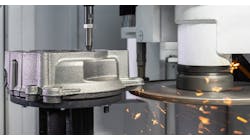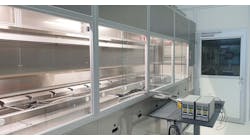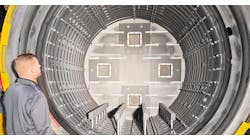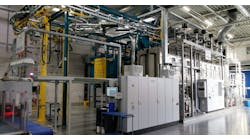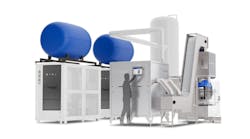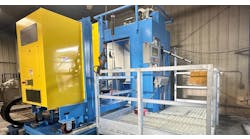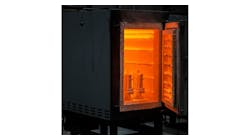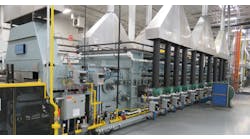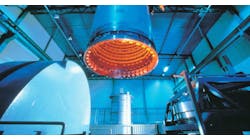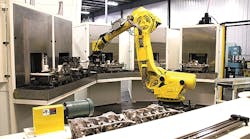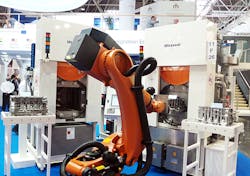To be honest, casting impregnation is an afterthought, a corrective action to address imperfections in the design and production of cast parts. Even with the best designs, the most careful plans, and the most exquisitely executed processes, castings develop surface porosity (microscopic voids) during solidification. The impregnation process seals the surface with a polymer formulation, applied under vacuum, so that the finished part can achieve the intended structural and leak-testing standards. Still, even though it is a complex and carefully considered process, impregnation is a detour from the continuous production sequence that is every manufacturer’s ideal.
The increasing importance of high-volume production of aluminum castings for automotive production is creating a wider demand for impregnation to offset the inherent risk of porosity on such parts. Metalcasters that want to perform the process in their own plants (versus contracting the service) have to address the issues that emerge with any afterthought: where and how to arrange the additional process, and how to operate it effectively.
Batch processing is one option. Lately, though, impregnation has become more manageable for high-volume metalcasting operations, and robots are an important reason for that.
Godfrey & Wing devised its Continuous Flow Impregnation (CFi) system for GM Powertrain as part of a fully automated engine manufacturing line: It can seal a single aluminum cylinder block in less than 98 seconds, a quick and efficient sequence that allows the foundry to integrate impregnation with finish machining, and achieving a First Time Through (FTT) acceptance rate above 99%.
The CFi system takes a single, fully machined cylinder block straight from the production line, and uses the robot to transfer it through the four-stage dry vacuum impregnation process. Along with the robot and a dry vacuum pressure (DVP) impregnation chamber using a low-viscosity sealant, there is a centrifuge to recover surplus sealant, a water wash/rinse stage, and a hot water curing stage that solidifies the sealant inside the casting porosity.
The impregnated cylinder blocks are impervious to the passage of gas or liquids that may cause gas or liquid leakage during service.
The short-cycle time made possible by the robot is important because most foundries have product variations, and must execute set-up changes without loss of productivity. The CFi system can process individual parts (large castings like engine blocks or heads, or transmission cases) or trays of smaller parts (fuel injection pumps, air conditioning compressors and power steering housings) in just a few seconds. The robot also makes it possible to operate around the clock, maximizing productivity. It operates with no direct labor, which lowers the hours/unit production cost.
Most important, according to G&W, its system is guaranteed to seal surface microporosity and complete post-impregnation cleaning, with a lower unit cost per finished casting, and environmental benefits.
Other advantages of robot-centered impregnation processes were revealed at GIFA 2015 once Ultraseal International introduced its R-FL-Duplex+ machine, which performs casting impregnation as a two-step process. It’s also a “small footprint” installation, which addresses the practical concern about incorporating an additional process step in a high-productivity foundry. It’s also designed as a modular operation, scalable up to 45 cycles per hour with the addition of extra vacuum modules.
Stephen Hynes, Ultraseal marketing director, called the R-FL-Duplex+ “a truly transformational machine and it wasn’t surprising that (GIFA) visitors were keen to hear about all of its advantages.
“It combines our acknowledged leadership in recycling sealant technology with our substantial experience in designing fully automated casting impregnation equipment to give unsurpassed results.
The R-FL-Duplex+ system works with either of Ultraseal’s polymer formulations, Rexeal 100™ and Ultraseal MX2™, making the process faster thanks to automation.
Traditionally, impregnation is carried out in three or four stages: parts are placed in a chamber and a vacuum is applied to draw air out of any “surface pores.” Then, a liquid sealant is introduced, followed by a wash cycle and then placement in ‘hot cure tank’ where the sealant is transformed into a solid plastic material. The Ultraseal process eliminates one of the three stages without compromising the quality of impregnation process.
By eliminating the cold wash stage of the process, and recycling sealant and water from the hot cure stage, R-FL-Duplex+ produces no aqueous effluent and requires no downtime for routine water changes.
“The R-FL-Duplex+ has a new hot-cure recycling process,” Kevin Siviter, technical manager, explained. “There is no wash station – parts go straight from the autoclave to the hot cure tank. It is a continuous, real-time process that is very robust and offers all the advantages of our recycling sealant technology.
“Customers will get the same impregnation quality as they would achieve with a three-module machine in regard to sealability and cleanliness, but the machine would take up one-third less space, less energy is required to run it and it has increased production throughput.”
Impregnation may be an afterthought in terms of casting design and development. It may not remain an afterthought for foundries seeking to maximize their opportunity in high-volume markets like automotive components. Reliable, automated processes anchored by robots to handle the repetitive motions and handling capacity needed to execute the sequence without adversely impacting throughput – or even raising productivity by increasing the percentage of high-quality finished parts.
